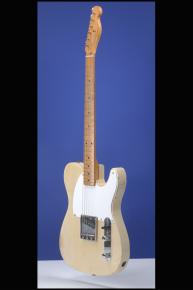A Totally Original Late '56 Esquire with a Huge V "Boat-Neck"
This fifty-five-year-old Blond beauty weighs just 7.20 lbs. and has a huge '57 style V "boat-neck" with a nut width of just over 1 5/8 inches and a scale length of 25 1/2 inches. Solid ash body and one-piece fretted maple neck with 21 frets and black dot position markers. "Transitional" single "butterfly" string tree in the same position as the round string tree. Headstock decal with Fender "spaghetti" logo in silver with black trim and "Esquire" in black below it (just below the "butterfly" string tree). Individual single-line Kluson Deluxe tuners with oval metal buttons. The tuning keys are stamped "2356766/PAT. APPLD." on the bottom base. The neck is dated "10-56" in pencil. Four-bolt neck plate with serial number ("16829") between the top two screws. One black six-polepiece "copper-coated metal plate bottom" pickup (with "Esquire" written in blue pencil on the bottom) with staggered polepieces (angled in bridgeplate) and an output of 5.78k. White single-layer ABS plastic pickguard (.060 inches thick) with five screws. On the face of the body, underneath the pickguard, "Esq" is written in blue pencil; in the bridge pickup cavity "Esq" is written in blue pencil; and there is an indecipherable blue marking in the neck pocket. Two controls (one volume, one tone) plus three-way "CRL 1452" "blender" switch and original Daka-Ware black plastic "Top-Hat" tip, all on metal plate adjoining pickguard. Shorter chrome knobs with flat tops and knurled sides. The potentiometers are stamped "304 620" (Stackpole May 1956) and the three capacitors between the switch and the volume control are stamped "ZSW .05 MFD 150 VDC." Telecaster combined bridge/tailpiece with three 1/4-inch steel smooth saddles, the screws angled at 45 degrees. This guitar is in excellent (8.50) condition. There is a very small "surface-only" crack on the back of the headstock just below the low "E" tuner (caused by overtightening of the lower screw), but this is merely a cosmetic mark and does not affect the integrity of the headstock in any way. In addition, a tiny piece of the white plastic pickguard by the bass waist has broken away, once again through overtightening of the screw. There is some light playing wear on the maple fretboard and some wear to the first ten frets (most noticeable on the first seven), but there is still life in these original fifty-five year-old frets. The varnish on the back of the neck is nicely worn away from being lovingly played and there is some playing wear on the body, mainly on the edges, where the guitar has rubbed against the player's body. There are also a few surface marks on the body. Overall, this fifty-five year-old gem is one of the nicest transitional "white guard" Esquires that we have ever seen! The Blond finish has mellowed to a rich, creamy color and the lovely grain of the ash body shows well through the finish. Housed in an eighties Fender black molded form-fit case with black plush lining (9.00).
"Leo Fender's new solidbody was the instrument that we know now as the Fender Telecaster, effectively the world's first commercially successful solidbody electric guitar...The guitar was originally named the Fender Esquire and then the Fender Broadcaster, and it first went into production in 1950. It was a simple, effective instrument. It had a basic, single-cutaway, solid slab of ash for a body, with a screwed-on maple neck. Everything was geared to easy production. It had a slanted pickup mounted into a steel bridge-plate carrying three adjustable bridge-saddles, and the body was finished in a yellowish color known as blond. It was unadorned and like nothing else. It was ahead of its time" (Tony Bacon, 50 Years of Fender, p. 10).
"After a false start the Esquire reappeared...in 1951, now with Fender's new adjustable truss-rod. It was offered in single-pickup format only, but otherwise was virtually identical to the two-pickup Telecaster. However, the Esquire's three-way selector functioned as a preset tone control or bypass switch, offering wide versatility from a one-pickup guitar. Perhaps surprisingly, the Esquire stayed in the line for 20 years" (Tony Bacon and Paul Day, The Fender Book, p. 10).
Translate:








